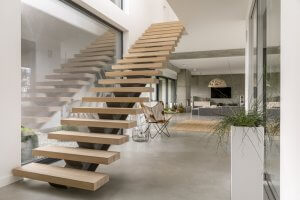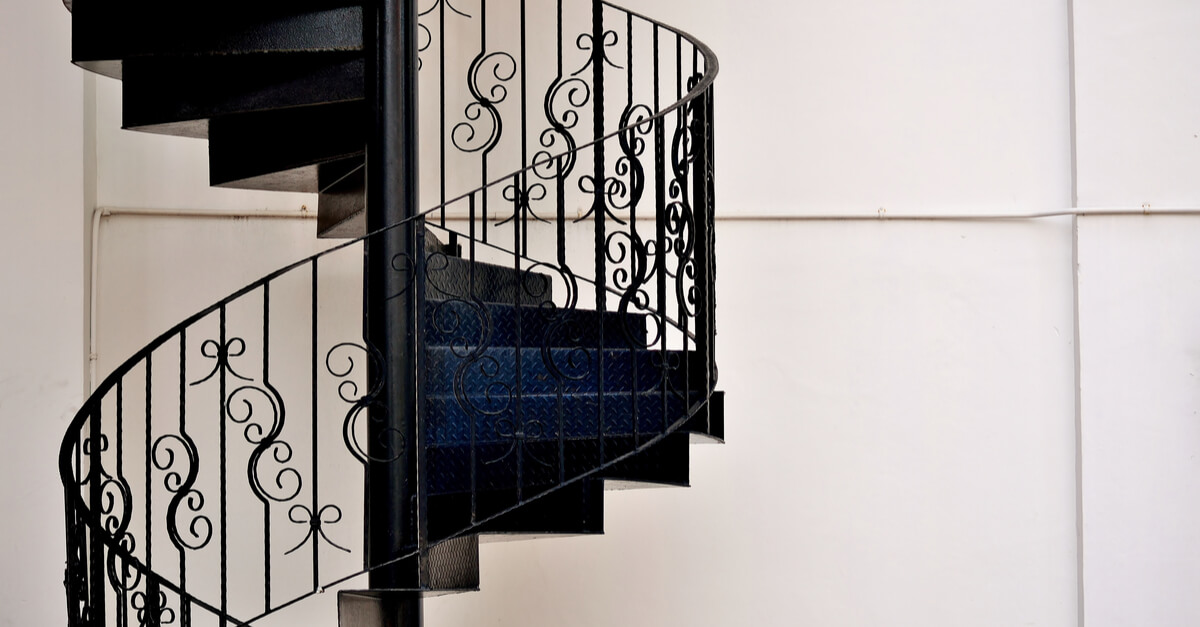Designing your Home: Types of Stairs

Stairs divide and connect the lower and upper floors. There are several types that you can consider and analyze before making a final choice for your home.
They come in an extensive variety of styles, materials, shapes, and sizes. Your stairs should match the design and main aesthetic of your home. So today, we’d like to show you the main types to think about.
Types of stairs
Some are long, undivided or divided into several sections, circular, floating, while others have rigid structures, different styles, and railings. Your choice should flow with the setting and correctly divide the two floors.

Fixed stairs
In construction, these are the most common option as they’re usually the most resistant. They’re generally straight and have a structure made of concrete or another strong material to sustain the steps. Straight staircases are a great example.
They’re fixed onto a wall and are compact, featuring a rail for support when going up or down the stairs. Straight staircases might include 1, 2, 3 or even 4 sections. In other words, if you choose a staircase with 2 sections, you would need a central landing in the middle.
Landings are used for longer distances. Or, landings can also connect to another space. Staircases with a central landing are common in 3-story homes. They divide and connect spaces, creating dynamism in the structure.
Additionally, fixed staircases can also be curved. These can be a great option if you want to create movement and use a more interesting structure in your home. They can also include central landings and different sections like straight stairs. Curved spirals, for example, can add a lot of personality to your home.
Floating stairs
Floating stairs are a great option for brightening up spaces. While connecting the two floors, they help light spread throughout the entire area because they’re only steps attached to the wall, creating more visual space.
They can come in different shapes and materials. But for these stairs, make sure to use a strong, firm handrail. Choose a material and style that matches your home.
Note: we don’t recommend floating models for homes with small children.
The most important part: materials
Now that we finished looking at the types that are available, we have to examine the materials. Stairs are made up of steps and rails. You can find marble, concrete, wood, aluminum, glass and iron stairs. Plan your design with just one material, like concrete or wood.
Concrete is strong but might make your home seem colder. If that’s what you’re aiming for, using small anti-slip rugs on each step could be a great idea. On the other hand, if you go with wood, make sure to take good care of it. Using plastic stair covers could make cleaning and maintenance much easier.
If you want to jazz your home up a bit, you could use two different materials. These days, an iron railing on a wooden staircase is a hot trend. Your home could enjoy the warmth from the stairs along with the contrast with the iron; it’s a perfect and incredibly beautiful combination.

Safety measures
Try to keep your steps to a standard size. If they’re too small, they could be uncomfortable to walk on or even dangerous.
And if you have small children that are starting to walk and explore the house, you should install baby gates on each end of all your staircases.
Choose a rail that you like, making sure that it matches your staircase in terms of the material and shape; and of course, make sure that it’s sturdy. Study the materials and layout of your home to choose the best stairs that’ll complement its design and structure. Stairs can even have a sculptural aspect to them if you choose an interesting design.